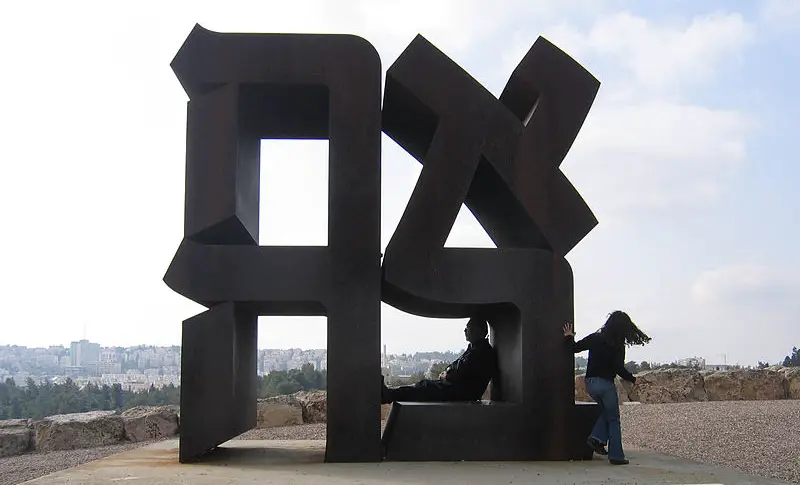For the past 27 years, I’ve called Israel my home. I spend my days talking, running errands, and living in Hebrew. While I’m not a native Israeli, after these years of consistent interaction and communication in Hebrew, I can confidently say I’m fluent in it. As someone deeply interested in vocabulary, I’ve begun a series dedicated to exploring Hebrew words. And what better word to start with than the Hebrew word for love!
Since that’s what you’re here to find out, I’ll get right to it – the Hebrew word for love is ‘ahava’.
But if you want to know a little about the background of this word, read on. In this post we’ll look into the modern evolution, as well as the biblical aspects behind this profound word. If you’re interested in its practical modern usage, check out my companion post ‘How to Say I Love You in Hebrew‘.
First, let’s take a look at the practical applications of ahava.
Pronunciation and Forms
| Word Form | Hebrew Script | Pronunciation | Usage | Example in Hebrew | Example Translation |
|---|---|---|---|---|---|
| Noun | אהבה | ah-ha-vah | Used to express the concept of love | אהבה חשובה. (Ahava hashuva.) | Love is important. |
| Verb | אוהב | oh-hev | Used to express the feeling of love or strong affection | אני אוהב אותך. (Ani ohev otach) | I love you. |
| Adjective | אהוב | ah-huv | Used to describe someone or something as loved | זה ספר אהוב עלי. (Ze sefer ahuv ah-lie) | This is a book I love. |
If you’re trying to learn Hebrew, go ahead and say the sample sentences out loud. Using your mouth is vital when learning to speak in a new language. Practicing pronunciation out loud is one of my favorite techniques, and it played a crucial role when I first started to learn Hebrew. If you’re interested in more effective ways to learn vocabulary, you might find my article on ‘75 Ways to Learn Foreign Vocabulary‘ useful.

The Israel Museum, Jerusalem, Photo by Talmoryair
Love in Hebrew Culture: From Traditional to Modern Times
In the previous section, we examined the practical usage of ‘ahava’, and just like everyone else, I have my own personal understanding of what love signifies. But I wondered – what is its significance in Hebrew culture?
To this end, serendipity played its part.
Dr. Guy Ehrlich, a close friend and distinguished scholar, was in town. Currently a postdoctoral fellow at Northwestern University, Guy was in Israel to receive the prestigious Yaacov Bahat Prize for Best Original Scholarly Book Manuscript in Hebrew, soon to be published by Haifa University Press. This honor is a testament to his deep understanding of Hebrew culture.
The fortunate part is that he teaches a course on Love in Modern Hebrew Literature and Israeli Culture back in Chicago, making him the perfect person to ask about this profound topic.
So, we sat down over a cup of coffee in Tel Aviv to discuss ‘love’ and its many facets, its emotional depths, and most importantly – its cultural significance.
The Evolution of Ahava in Hebrew Culture
He provided a captivating insight into how the concept has evolved over time.
In traditional Jewish society, the concept of romantic love was quite foreign, largely due to the prevalence of arranged marriages. “Romantic love wasn’t a thing,” he said. “No one cared if you had feelings for your future wife when you’re 12, and they set you up with your future wife who is 11. Feelings had no place there.” However, with the arrival of the Jewish Enlightenment movement – the Haskala, spurred by the wider European Enlightenment – a new concept of romantic love started to appear.
According to Guy, a recurring theme in the early works of modern Hebrew literature was that of the “passive man” who cannot fulfill his Eros. He struggled to find and express love. This man, having left his traditional shtetl life to embrace modern European culture, found himself stuck between two worlds – unable to fit into either entirely. As Guy put it, this man was ‘talush,’ uprooted, and this sense of displacement extended to his erotic life. He had no idea what romantic love was because it was so foreign to him.
However, this started to change as the process of secularization took hold, and with the rise of Zionism. The ‘broken man’ narrative underwent a deliberate shift, with the passive Jewish man being replaced by the new, strong, active ‘Sabra.’
The influence of European literature, where romantic love was a dominant theme, played a role in this transformation as well. As Jewish life started to modernize and secularize, transitioning from traditional shtetls to becoming a part of Europe, and later, the new state of Israel, the concept of romantic love found its place and importance.

Love in the Hebrew Bible and Scriptures
The Hebrew Bible and scriptures paint a nuanced and multifaceted picture of love. As an emotion, love takes on various forms and expressions. Hebrew language embraces this complexity with a range of words, each having its unique contexts and connotations.
In this section we’ll explore three of these Hebrew words for love – ‘ahava’, ‘dodim’, and ‘hesed’. While they all touch upon the essence of love, they offer different perspectives, illustrating the depth and richness of love.
Ahava (אהבה): Ahava is the Hebrew word for love that sees the most frequent use. It captures various kinds of love – from romantic and familial to the love for objects or ideas
Dodim (דֹודִים): This word is a plural form of ‘dod’, which means beloved or loved one. The Song of Songs predominantly uses ‘Dodim’ to denote expressions of love, often with romantic or sensual connotations. It emphasizes the mutual affection, desire, and intimacy between lovers.
Hesed (חסד): Often translated as loving-kindness or mercy, ‘hesed’ is a key concept in Jewish theology, representing a form of love that is compassionate, faithful, and enduring. Predominantly used in the context of the covenantal relationship between God and the people of Israel, it implies love that transcends duty, highlighting generosity and benevolence freely given.
Here are some examples:
The Book of Ruth
The Book of Ruth presents a beautiful portrayal of the Hebrew word for love—hesed—through the relationship between Ruth and her mother-in-law, Naomi. Their bond showcases a deep and devoted kind of love that goes beyond duty or obligation.
Psalms
In Psalms, the love of God, often expressed as ahav or hesed, is a recurring theme. It is portrayed as a steadfast and unfailing aspect of God’s character. Significantly, it’s not temporary; it endures through time.
David and Solomon
Two prominent figures in the Hebrew Bible—David and Solomon—offer insight into ‘ahava’, love in Hebrew. David and Jonathan’s bond signifies ‘ahava‘ as deep friendship. Solomon’s relationships, especially with foreign women, express ‘ahava’ as romantic, sensual love
Song of Songs
The Song of Songs, a lyrical masterpiece attributed to King Solomon, offers an intoxicating exploration of romantic love. ‘Dodim‘, meaning ‘beloved’ or ‘love’, is brought to life through passionate, sensual imagery. Though it highlights mutual affection between lovers, it’s often seen as symbolizing God’s deep love for His children. This gives us a different and multi-layered perspective on the Hebrew concept of ‘Ahava’.
Deuteronomy 4:37
In Deuteronomy 4:37, we find a beautiful example of God’s love—ahav—for His people. This passage demonstrates God’s love as an action and a commitment to the welfare of His people, rather than a simple sentimental emotion.
Jeremiah 31:3
Jeremiah 31:3 provides another depiction of love in Hebrew—hesed. Here God’s love is seen as everlasting, transcending mere affection to represent a divine bond between God and His people.
While Biblical Hebrew love words offer rich insight into this multifaceted emotion, their everyday use has evolved. For instance, if you were to use ‘hesed’ or ‘dodim’ casually in modern Israel, you may get puzzled looks. ‘Ahava’ now often expresses love, from romantic to familial, even for objects or ideas. These ancient terms remain valuable for theological or literary discussions, but have less everyday relevance.
Love in Hebrew: A Timeless Tale
In wrapping up our journey through love in Hebrew culture, we’ve seen the multifaceted nature of this universal emotion. Initially, from its intricate portrayal in biblical times with words like ‘ahava’, ‘dodim’, and ‘hesed’, to its evolving meaning in modern Israeli society, love remains a dynamic and powerful concept.
It is also quite interesting to observe how global trends and societal changes have actively shaped the contemporary understanding of love, without erasing the significance of the historical and religiously imbued terms. Despite its transformations over time, fundamentally, love in Hebrew, much like elsewhere, emphasizes connection, compassion, and commitment.
Lastly, the Hebrew language, with its varied vocabulary for love, captures this emotion in all its depth, thus offering a unique lens through which to explore the essence of love.
If you’re curious about different strategies to learn Hebrew effectively, don’t hesitate to check out my article on ‘19 Ways to Learn Hebrew‘.




